Process for preparing detergent compositions having high bulk density
a technology of detergent composition and bulk density, applied in the field of detergent granules, can solve the problems of agglomeration of granules, formation of coarse granules, and complicated mixing of mixers
- Summary
- Abstract
- Description
- Claims
- Application Information
AI Technical Summary
Benefits of technology
Problems solved by technology
Method used
Image
Examples
example 1
[0130]The detergent composition having the composition shown in Table 1 was prepared in an amount of 35 kg for each unit using a high speed mixer “Lödige Mixer FKM-130D” (manufactured by Matsubo Co., Ltd.). This mixer was equipped with agitator blades and a shearing device, the shearing device corresponding to a chopper for disintegration and dispersion.
[0131]Here, the following procedures were carried out.
Powder Blending
[0132]The solid ingredients consisting of 7.0 parts by weight of sodium tripolyphosphate (STPP; average particle size: 11.2 μm), 12.61 parts by weight of sodium carbonate (“LIGHT ASH,” manufactured by Central Glass Co., Ltd.; average particle size: 56.1 μm), and 0.11 parts by weight of a fluorescer were blended for one minute under the conditions of a rotational speed of agitator blades of 130 rpm (peripheral speed: 3.4 m / s) and a rotational speed of shearing device of 2850 rpm (peripheral speed: 27 m / s) by the Lödige Mixer.
Addition of Reaction Initiating Agent
[0133...
example 2
[0139]Similar composition and procedures to those in Example 1 were employed except for respectively changing the amounts of LIGHT ASH and sulfuric acid to 12.45 parts by weight and 0.57 parts by weight, to give a detergent composition. The fracture load of the granules obtained after the neutralization and granulation step was 742 gf, and the average particle size of the granules was 632 μm.
[0140]The resulting granules of the detergent composition, prior to the after-blending step, had percentage of particles with 1400 μm-pass: 82.6%; average particle size: 517 μm; bulk density: 730 g / L; free-flowability: 6.3 seconds; and hue: 91.4. Accordingly, the granules showed excellent properties.
[0141]Incidentally, the proportion of sulfuric acid to the LAS during neutralization reaction was such that the reaction mixture contained 0.23 mol of sulfuric acid per mol of the LAS. The amount of sodium carbonate was about five times the amount required for neutralizing the LAS and sulfuric acid.
example 3
[0142]Similar composition and procedures to those in Example 1 were employed except for respectively changing the amounts of LIGHT ASH and sulfuric acid to 12.33 parts by weight and 0.82 parts by weight, to give a detergent composition.
[0143]The resulting granules of the detergent composition, prior to the after-blending step, had percentage of particles with 1400 μm-pass: 83.8%; average particle size: 496 μm; bulk density: 717 g / L; free-flowability: 6.2 seconds; and hue: 91.5. Accordingly, the granules showed excellent properties.
[0144]Incidentally, the proportion of sulfuric acid to the LAS during neutralization reaction was such that the reaction mixture contained 0.3 mol of sulfuric acid per mol of the LAS. The amount of sodium carbonate was about four times the amount required for neutralizing the LAS and sulfuric acid.
PUM
 Login to View More
Login to View More Abstract
Description
Claims
Application Information
 Login to View More
Login to View More - R&D
- Intellectual Property
- Life Sciences
- Materials
- Tech Scout
- Unparalleled Data Quality
- Higher Quality Content
- 60% Fewer Hallucinations
Browse by: Latest US Patents, China's latest patents, Technical Efficacy Thesaurus, Application Domain, Technology Topic, Popular Technical Reports.
© 2025 PatSnap. All rights reserved.Legal|Privacy policy|Modern Slavery Act Transparency Statement|Sitemap|About US| Contact US: help@patsnap.com



